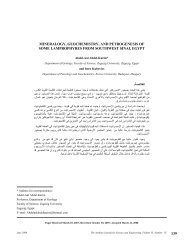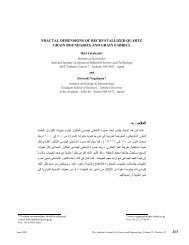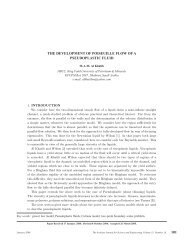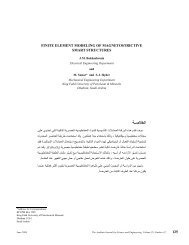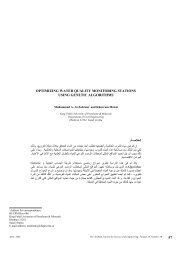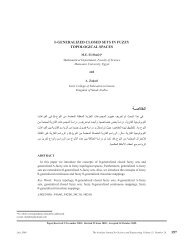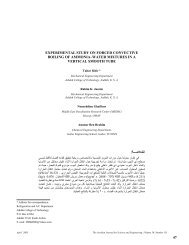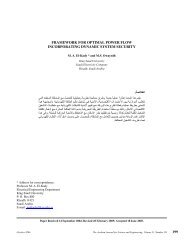lambert universal variable algorithm - Arabian Journal for Science ...
lambert universal variable algorithm - Arabian Journal for Science ...
lambert universal variable algorithm - Arabian Journal for Science ...
You also want an ePaper? Increase the reach of your titles
YUMPU automatically turns print PDFs into web optimized ePapers that Google loves.
M.A. Sharaf, A.N. Saad, and M.I. Nouh<br />
1. INTRODUCTION<br />
LAMBERT UNIVERSAL VARIABLE ALGORITHM<br />
Lambert problem of space researches is concerned with the determination of an orbit from two position vectors and the<br />
time of flight [1]. It has very important applications in the areas of rendezvous, targeting, guidance [2], and<br />
interplanetary mission [3].<br />
Solutions to Lambert’s problem abound in the literature, as they did even in Lambert’s time shortly after his original<br />
<strong>for</strong>mulation in 1716. Examples are Lambert’s original geometric <strong>for</strong>mulation, which provides equations to determine the<br />
minimum-energy orbit, and the original Gaussian <strong>for</strong>mulation, which gives geometrical insight into the problem.<br />
Up to the year 1965, a fairly comprehensive list of references on Lambert’s problem are given in references [4–6].<br />
In 1969, Lancaster and Blanchard [7] (also Mansfield [8]) established unified <strong>for</strong>ms of Lambert’s problem; in 1990<br />
Gooding [9] developed a procedure <strong>for</strong> the solution; and in 1995, Thorne and Bain [10] developed a direct solution using<br />
the series inversion technique.<br />
Each of the above methods is characterized primarily by: (1) a particular <strong>for</strong>m of the time of flight equation; and<br />
(2) a particular independent <strong>variable</strong> to be used in an iteration <strong>algorithm</strong> to determine the orbital elements.<br />
One of the most compact and computationally efficient <strong>for</strong>ms of Lambert’s problem is that of Battin (cited in<br />
reference [11]). In this <strong>for</strong>m, the time of flight equation is <strong>universal</strong> (i.e., includes elliptic, parabolic, and hyperbolic<br />
orbits) as a well-behaved function of a single, physically significant, independent <strong>variable</strong>.<br />
In the present paper, we aim at building an <strong>algorithm</strong> <strong>for</strong> <strong>universal</strong> Lambert’s problem on the basic approach of Battin,<br />
extending it to include the following important points: (1) An iterative scheme which converges <strong>for</strong> all orbit types; and<br />
(2) an efficient procedure to evaluate the Stumpff’s functions. Applications of the <strong>algorithm</strong> are also given.<br />
2. BASIC FORMULATIONS<br />
2.1. Two-Body Formulations<br />
• The equation describing the relative motion of the two bodies of masses m1 and m2 in rectangular coordinates is:<br />
d µ<br />
v= r =− r 3 , (2.1)<br />
dt r<br />
where µ is the gravitational parameter (<strong>universal</strong> gravitational constant times the sum of the two masses), r and v<br />
are the position and velocity vectors given in components as:<br />
r = x i + y i + z i , (2.2)<br />
x y z<br />
v= x i + y i + z i , (2.3)<br />
x y z<br />
ix, iy, and iz are the unit vectors along the coordinate axes x, y, and z respectively, and<br />
2 2 2 1 2<br />
r = ( x + y + z ) . (2.4)<br />
Equation (2.1) is unchanged if we replace r with –r. Thus Equation (2.1) gives the motion of the body of mass m2<br />
relative to the body of the mass m1, or the mass m1 relative to m2. Also, if we replace t with –t, Equation (2.1)<br />
remains unchanged.<br />
88 The <strong>Arabian</strong> <strong>Journal</strong> <strong>for</strong> <strong>Science</strong> and Engineering, Volume 28, Number 1A. January 2003



